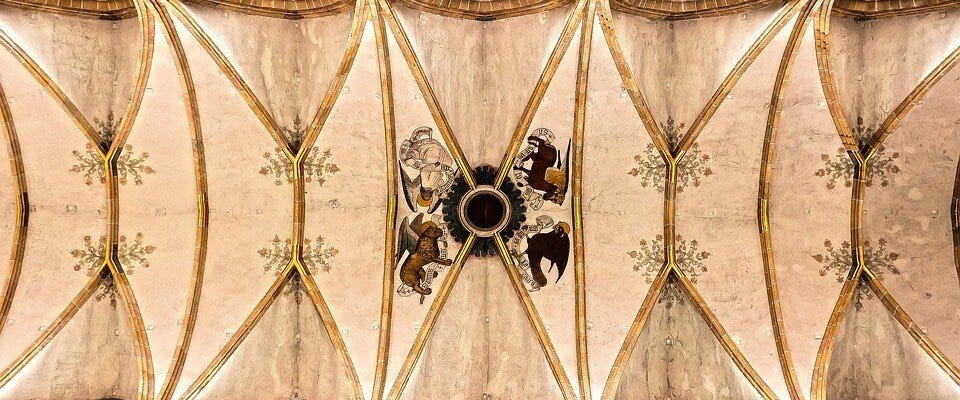(This essay was originally published at First Things.)
I was born in Urk, a tiny fishing town in the Netherlands. Urk was an island just off the coast, famous for its kotters: small fishing boats that iconically represented the unique life and culture of this small, Reformed town. A dike was built in 1939, connecting the island to the mainland. The unprecedented land reclamation project that followed during and after the Second World War incorporated Urk within a larger polder and made it an integral part of the rest of the country. The fishing industry hasn’t disappeared, but it’s a pale shadow of what it once was.
My family left Urk when I was three years old. Occasionally, my dad would take me back. As a Reformed pastor, he would sometimes preach in the town where we used to live. Upon arrival at the town church, he would plunk me in the front row, where I gazed in admiration upon the model of the kotter suspended from the ceiling, right in front of the pulpit. Only later did I realize the irony of gazing upon a kotter rather than a crucifix. The kotter was the one and only image that had managed to gain legitimacy in this Dutch Reformed Church.
My dad was keenly aware of the unity of nature and the supernatural. He explained to me that the fishing boat was not only a symbol of the economic and cultural heritage of the town, but was also a miniature representation of the church. The church, he explained, was a fishing boat like those of the Gospels, with God’s people as the disciples and the minister speaking the words of Christ to them. It is in the schip of the church—nave in English (from the Latin navis, boat)—that the faithful have their place.
It is not my purpose to defend (or disparage) the Dutch Reformed iconography of kotters. Let’s just say it is powerful.
No matter how sharp the architectural (and liturgical) caesura introduced by the sixteenth-century Reformation, the church’s kotter—as well as historic Reformed church architecture in general—deliberately linked up with the patristic and medieval heritage. Compared to recent church planners (one hates to call them architects), the Reformers were iconoclastic amateurs. Only recently have evangelicals truly managed to cut the link with the church of all times and places in terms of architecture.
I was reminded of all this while reading On the Ecclesiastical Mystagogy by Saint Maximus the Confessor, recently retranslated by the evangelical theologian Jonathan Armstrong and published by the Orthodox publishing house St. Vladimir’s Seminary Press. The seventh-century monastic theologian was a staunch advocate of the unity of nature and the supernatural, and he recognized that his metaphysical convictions had architectural implications.
Throughout the book, Maximus explains how nature and the supernatural are linked. He discusses the relation between the sensible and the intelligible realms of the cosmos, between body and soul in the human being, between Old and New Testament in Holy Scripture, and—crucially for our topic—between nave and sanctuary in the church.
As a Christian Platonist, Maximus was fully cognizant that sensible and intelligible realities are not one and the same thing. He also was convinced that the latter are of greater significance than the former. At no point, however, did Maximus reject the body out of concern for the soul. To do so would have forced him architecturally to discard the nave in favor of the sanctuary. Maximus would have none of it.
Saint Maximus saw the building of the church as a figure (typos) and icon (eikōn) of the cosmos. Just as unity and diversity characterize the cosmos, so too the church’s one building consists of two parts, nave and sanctuary. Maximus hammers home his conviction that the differences between the two parts do not divide them: “The nave is the sanctuary in potency by being consecrated by the relationship toward its end, and in turn the sanctuary is the nave in act by possessing the principle of its own sacrament, which remains one and the same in its two parts.” The nave has the sanctuary as its end, and the sanctuary (with the altar) is the origin of the church’s mystagogical rite.
Maximus borrows the Chalcedonian terms “unconfused” and “undivided” to draw attention to the unity and diversity of the church’s floor plan. Without explicitly alluding to Christology, Saint Maximus appears to claim that the mystery of the church building’s unity echoes that of the Incarnation itself. Maximus refused to treat church architecture as a neutral endeavor. He would have been unpersuaded by the claim that a gym is of similar (or perhaps superior) spiritual value as a Gothic church.
Maximus was a metaphysical realist. He believed that the lower tier of reality (sensible things, body, Old Testament, church nave) is patterned on the higher tier of reality (intelligible things, soul, New Testament, church sanctuary). On a Maximian view, the church building ought to consist of nave and sanctuary because a church must be designed in line with the Chalcedonian structure of the cosmos—unconfused and undivided.
Maximus’s argument falls flat in today’s philosophical climate. Perhaps we humor traditionalist ecclesial architecture for its nostalgic adherence to ancient and antiquated building styles. But deep down we are convinced that Maximus’s link between nave and sanctuary is nothing but a fanciful theological rationalization of an architectural construct—one whose origin is simply the subjective aesthetic or pragmatic judgments of the architect. On the modern view, church buildings are neutral constructs of pura natura, shorn of metaphysical import. (In truth, of course, there is nothing neutral about constructing a church as a gym or a theater.) The recovery of meaningful church architecture hinges upon the retrieval of a realist metaphysic.
I’m not sure what Maximus would have thought of kotter iconography. But surely, he would have recognized that it is only in ships that you can reach the safety of the harbor.


